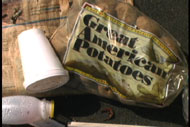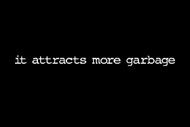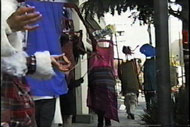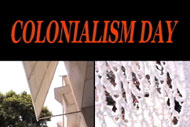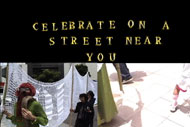 |
July
2002 volume 1, issue 1 |
| |
|
|
Interview with A-Clip (continued | 1,
2, 3, 4) Klaus Weber: No, that’s not the point. A commodified lifestyle and social intelligence came into the capital, and the city itself became the product, Katja Eydel:I think three things are important to mention; reunification, the addition of the new market center and the partial reconstruction of urban space in the vast lands of East Berlin. Lastly it was really concrete that the living circumstances had changed for each participant of the campaign. It was easy for many of us to say, "this is where I live, this is my living space, I can get involved and get active", without being accused by others of acting like a social worker. Christina Ulke: Did the coalition between the art scene and the activist scene happen because of the proximity of artists and activists in Berlin-Mitte? Klaus Weber: I think the coalition was borne out of a strong desire from the activist scene and the art scene. Activists were reaching out to the art scene because they felt that they had reached the border of their practice. They were sick of their own political aesthetics and wanted to enrich their political strategies. On the other side — among the artists - there was a desire towards "real" politics because people in the art scene who came from conceptual art had gotten further away from the practice of sculpture or painting and had become involved with philosophy, theoretical practice and politics. They had a desire to become more radicalized and more concrete. So there was a congruent line of desire, which worked two ways. That is why the people could meet. It was not only mutual projection, it was a desire and an imagination of a place where they could meet. Christina Ulke: You mentioned earlier that one of achievements at ‘Minus 96’ was the conceptualization of a nationwide campaign against gentrification. Klaus Weber: Yes, in 1997, ‘innenstadtaktion’ — inner city action - which was the most boring name but we didn’t find another. Gentrification was one aspect of the campaign. It was a campaign against the recapitalization of the inner city districts and it’s consequences - social exclusion (law and order) and redundant urban environment. Katja Eydel:
It was a coalition of West-German groups and us from former West Berlin,
no one from the former GDR or East Berlin. Katja Eydel: Difficult to say, we never had the chance to figure it out. I would guess that there are so many differences in language, differences in attitude. We talked about it, it was a reoccurring issue, there were several outreach attempts for example through Scheinschlag, a local eastern newspaper… So at that point there were coalitions among cities, like Düsseldorf, Cologne, Frankfurt, Munich and Hamburg. We decided to do a nationwide week of actions in June 97. Participating groups were free to figure out how to take public action, but the time schedule was coordinated. We had a mailing list and a newspaper, which was part of the TAZ, the leftist daily newspaper in Berlin. We also organized demonstrations. Klaus Weber: ..so-called direct actions, orchestrated interventions. Katja Eydel: There were other events happening too. We didn’t know who organized them. It was such a movement, so many people responded to this issue. A lot of things came together, we realized the topic was in the air. Many could relate to it, satisfy their own desires and realize themselves. That was quite considerable. Klaus Weber: Even in suburban outskirts of cities, in small town villages, there were people who made something at the same time. Katja Eydel: We generated a nationwide dialogue up to the point where we got television involved. Corporate media picked up the issue. Before our campaign, gentrification wasn’t part of the public space or discourse. All of a sudden the concept was articulated. After 2 years we had to ask ourselves, what had we done? We had provided mainstream media with a critical discourse model, which they used for their own interests where issues of privatization and exclusion were reevaluated as security measures. One year later, we organized inner city action again in a smaller scale. Then we had doubts that we were no different from mainstream media, in what we had to say, in what already existed. We had the feeling that we had started a process, which then went beyond our control. Klaus Weber: But this is okay, I mean you can never control the waves that come from a stone that you have thrown into the water. Katja Eydel: But you can determine the level of your attractiveness. |
|||
|
|
||||



